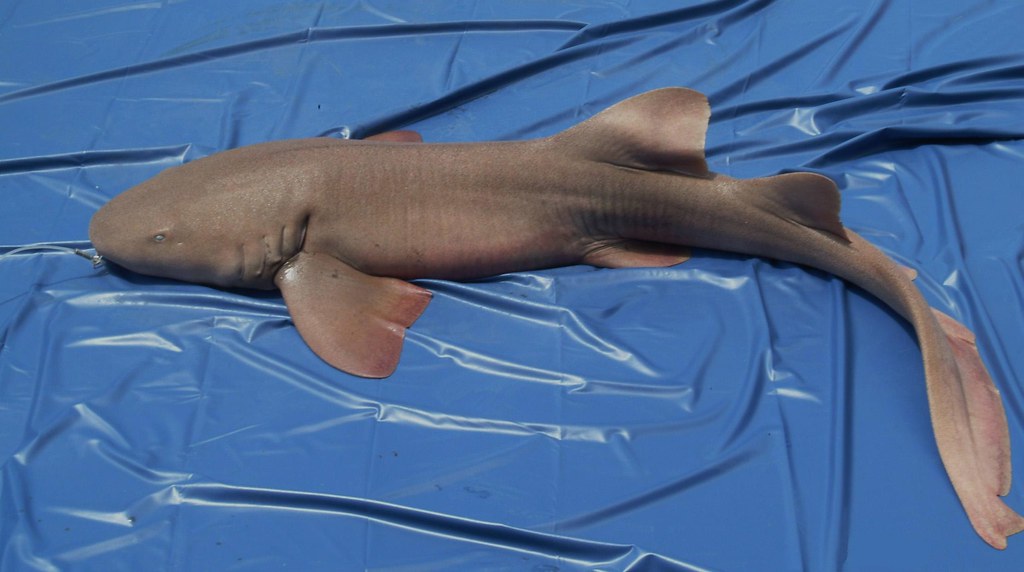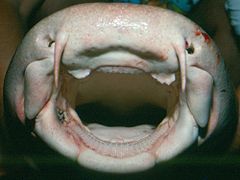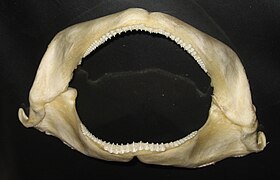Map Snapshot

0 Records
Seasonality Snapshot
No Records
Source: Wikipedia
| Nurse shark | |
|---|---|
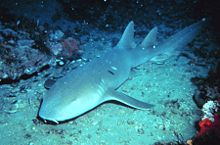
| |
| Scientific classification | |
| Domain: | Eukaryota |
| Kingdom: | Animalia |
| Phylum: | Chordata |
| Class: | Chondrichthyes |
| Subclass: | Elasmobranchii |
| Order: | Orectolobiformes |
| Family: | Ginglymostomatidae |
| Genus: | Ginglymostoma |
| Species: | G. cirratum
|
| Binomial name | |
| Ginglymostoma cirratum (Bonnaterre, 1788)
| |
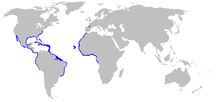
| |
| Range in blue | |
The nurse shark (Ginglymostoma cirratum) is an elasmobranch fish in the family Ginglymostomatidae. The conservation status of the nurse shark is globally assessed as Vulnerable in the IUCN List of Threatened Species.[2] They are considered to be a species of least concern in the United States and in The Bahamas, but considered to be near threatened in the western Atlantic Ocean because of their vulnerable status in South America and reported threats throughout many areas of Central America and the Caribbean.[2] They are directly targeted in some fisheries and considered by-catch in others.
Nurse sharks are an important species for shark research.[3] They are robust and able to tolerate capture, handling, and tagging extremely well.[4] As inoffensive as nurse sharks may appear, they are ranked fourth in documented shark bites on humans,[5] likely due to incautious behavior by divers on account of the nurse shark's calm, sedentary nature.
Taxonomy
[edit]The nurse shark genus Ginglymostoma is derived from Greek language meaning hinged mouth, whereas the species cirratum is derived from Latin meaning having curled ringlets. Based on morphological similarities, Ginglymostoma is believed to be the sister genus of Nebrius, with both being placed in a clade that also include species Pseudoginglymostoma brevicaudatum, Rhincodon typus, and Stegostoma fasciatum.[6]
The name "nurse" may have originated from antiquated spelling conventions. The Oxford English Dictionary notes that, in medieval times, the "n" of the word "an" was frequently transferred to a following word that began with a vowel. Huss, husse and hurse were antiquated names for dogfish and other sharks. Nurse survives and so does huss.[7]
Description
[edit]The nurse shark has two rounded dorsal fins, rounded pectoral fins, an elongated caudal fin, and a broad head.[8] Maximum adult length is currently documented as 3.08 m (10 ft 1+1⁄2 in), whereas past reports of 4.5 m (15 ft) and corresponding weights of up to 330 kg (730 lb) are likely to have been exaggerated.[2] Adult nurse sharks are brownish in color. Newly born nurse sharks have a spotted coloration which fades with age and are about 30 cm in length when nascent.
-
Head
-
Mouth
-
Jaws
-
Teeth



Distribution and habitat
[edit]The nurse shark has a wide but patchy geographical distribution along tropical and subtropical coastal waters of the Eastern Atlantic, Western Atlantic, and Eastern Pacific.[9] In the Eastern Atlantic it ranges from Cape Verde to Gabon (accidental north to France).[2] In the Western Atlantic, including the Caribbean, it ranges from Rhode Island to southern Brazil,[10] and in the East Pacific from Baja California to Peru.[2]
Nurse sharks are a typically inshore bottom-dwelling species. Juveniles are mostly found on the bottom of shallow coral reefs, seagrass flats, and around mangrove islands, whereas older individuals typically reside in and around deeper reefs and rocky areas, where they tend to seek shelter in crevices and under ledges during the day and leave their shelter at night to feed on the seabed in shallower areas.[11]
Nurse sharks are also subject to piebaldism, a genetic condition that results in a partial lack of body pigmentation and a speckled body.[12]
Biology and ecology
[edit]Nurse sharks are opportunistic predators that feed primarily on small fish (e.g. stingrays) and some invertebrates (e.g. crustaceans, molluscs, tunicates).[11] They are typically solitary nocturnal animals, rifling through bottom sediments in search of food at night, but are often gregarious during the day forming large sedentary groups. Nurse sharks are obligate suction feeders capable of generating suction forces that are among the highest recorded for any aquatic vertebrate to date.[13][14] Although their small mouths may limit the size of prey, they can exhibit a suck-and-spit behavior and/or shake their head violently to reduce the size of food items.[15]
Nurse sharks are exceptionally sedentary unlike most other shark species.[16] Nurse sharks show strong site fidelity (typical of reef sharks), and it is one of the few shark species known to exhibit mating site fidelity,[17] as they will return to the same breeding grounds time and time again.
American alligators (Alligator mississippiensis) and American crocodiles may occasionally prey on nurse sharks in some coastal habitats. Photographic evidence and historical accounts suggest that encounters between species are commonplace in their shared habitats.[18][19]
Reproduction
[edit]Nurse sharks are ovoviviparous, with fertilized eggs hatching inside the female. The mating cycle of nurse sharks is biennial, with females taking up to 18 months to produce a new batch of eggs. The mating season runs from late June to the end of July, with a gestation period of six months and a typical litter of 21–29 pups.[10] The young nurse sharks are born fully developed at about 30 cm long.
Nurse sharks engage in multiple paternity during mating season. A study conducted over a ten-year span found that a brood of nurse sharks had more genotypes than broods with one father. 14 separate genotypes were found in the brood examined, which suggests that more than one father fertilized the mother's eggs. Engagement in multiple paternity promotes genetic variation.[20]
See also
[edit]References
[edit]- ^ Sepkoski, J. (2002). "A compendium of fossil marine animal genera (Chondrichthyes entry)". Bulletins of American Paleontology. 364: 560.
- ^ a b c d e f Carlson, J.; Charvet, P.; Blanco-Parra, MP; Briones Bell-lloch, A.; Cardenosa, D.; Derrick, D.; Espinoza, E.; Herman, K.; Morales-Saldaña, J.M.; Naranjo-Elizondo, B.; Pérez Jiménez, J.C.; Schneider, E.V.C.; Simpson, N.J.; Talwar, B.S.; Pollom, R.; Pacoureau, N.; Dulvy, N.K. (2021). "Ginglymostoma cirratum". IUCN Red List of Threatened Species. 2021: e.T144141186A3095153. doi:10.2305/IUCN.UK.2021-1.RLTS.T144141186A3095153.en. Retrieved 18 November 2021.
- ^ Osgood, G. J and J. K. Baum. (2015). "Reef sharks: recent advances in ecological understanding to inform conservation". Journal of Fisheries Biology. 87 (6): 1489–1523. Bibcode:2015JFBio..87.1489O. doi:10.1111/jfb.12839. PMID 26709218.
- ^ Aucoin, S.; Weege, S.; Toebee, M.; Guertin, J.; Gorham, J.; Bresette, M. (2017). "A new underwater shark capture method used by divers to catch and release nurse sharks (Ginglymostoma cirratum)". Fishery Bulletin. 115 (4): 484–495. doi:10.7755/FB.115.4.5.
- ^ Ricci, J. A.; Vargas, C. R.; Singhal, D.; Lee, B. T. (2016). "Shark attack-related injuries: epidemiology and implications for plastic surgeons". Journal of Plastic, Reconstructive & Aesthetic Surgery. 69 (1): 108–114. doi:10.1016/j.bjps.2015.08.029. PMID 26460789.
- ^ Goto, T. (2001). "Comparative Anatomy, Phylogeny and Cladistic Classification of the Order Orectolobiformes (Chondrichthyes, Elasmobranchii)". Memoirs of the Graduate School of Fisheries Science, Hokkaido University. 48 (1): 1–101.
- ^ "Where did "Nurse" shark come from?".
- ^ McEachran, J.; Fechhelm, J.D. (1998). Fishes of the Gulf of Mexico, Vol. 1: Myxiniformes to Gasterosteiformes. Austin: University of Texas Press. p. 45. ISBN 978-0-292-75206-1. OCLC 38468784. Retrieved 13 July 2021.
- ^ Compagno, L.J.V. (2002). Bullhead, mackerel and carpet sharks (Heterodontiformes, Lamniformes and Orectolobiformes). Family Ginglymostomatidae. In: Sharks of the World: An Annotated and Illustrated Catalogue of Shark Species Known to Date, vol. 2. Food and Agriculture Organization of the United Nations. pp. 188–195.
- ^ a b Compagno, L.J.V. (1984). Sharks of the World: An Annotated and Illustrated Catalogue of Shark Species Known to Date. Food and Agriculture Organization of the United Nations. pp. 205–207, 555–561, 588.
- ^ a b Castro, J. I. (2000). "The biology of the nurse shark, Ginglymostoma cirratum, off the Florida east coast and the Bahama Islands)". Environmental Biology of Fishes. 58 (1): 1–22. Bibcode:2000EnvBF..58....1C. doi:10.1023/A:1007698017645. S2CID 32772305.
- ^ "Piebald nurse shark with incredible speckled skin may be first on record | Sharks | Earth Touch News". Earth Touch News Network. Retrieved 2023-03-16.
- ^ Tanaka, S. K. (1973). "Suction feeding by the nurse shark". Copeia. 1973 (3): 606–608. doi:10.2307/1443135. JSTOR 1443135.
- ^ Motta, P. J., Hueter, R. E., Tricas, T. C., Summers, A. P., Huber, D. R., Lowry, D., Mara, K. R., Matott, M. P., Whitenack, L. B., Wintzer, A.P. (2008). "Functional morphology of the feeding apparatus, feeding constraints, and suction performance in the nurse shark Ginglymostoma cirratum". Journal of Morphology. 269 (9): 1041–1055. doi:10.1002/jmor.10626. PMID 18473370. S2CID 15066259.
{{cite journal}}: CS1 maint: multiple names: authors list (link) - ^ Motta, P. J. (2004). Prey capture behavior and feeding mechanics of elasmobranchs. In Biology of sharks and their relatives. CRC Press, Taylor & Francis Group. pp. 165–202.
- ^ Heithaus, M.R., Burkholder, D., Hueter, R. E., Heithaus, L. I., Prat Jr. H. L., Carrier, J. C. (2004). Reproductive biology of elasmobranchs. In: Biology of sharks and their relatives. CRC Press, Taylor & Francis Group. pp. 269–286.
{{cite book}}: CS1 maint: multiple names: authors list (link) - ^ Carrier, J. C., Pratt, H. L., Castro, J. I. (2004). "Spatial and temporal variation in shark communities of the lower Florida Keys and evidence for historical population declines". Canadian Journal of Fisheries and Aquatic Sciences. 64 (10): 1302–1313. doi:10.1139/f07-098.
{{cite journal}}: CS1 maint: multiple names: authors list (link) - ^ Jason Bittel (20 September 2017). "Alligators Attack and Eat Sharks, Study Confirms". National Geographic. Archived from the original on September 20, 2017.
- ^ Nifong, James C.; Lowers, Russell H. (2017). "Reciprocal Intraguild Predation between Alligator mississippiensis (American Alligator) and Elasmobranchii in the Southeastern United States". Southeastern Naturalist. 16 (3): 383–396. doi:10.1656/058.016.0306. S2CID 90288005.
- ^ Saville, Kenneth J.; Lindley, Andrea M.; Maries, Eleanora G.; Carrier, Jeffrey C.; Pratt, Harold L. (2002-03-01). "Multiple Paternity in the Nurse Shark, Ginglymostoma Cirratum". Environmental Biology of Fishes. 63 (3): 347–351. Bibcode:2002EnvBF..63..347S. doi:10.1023/A:1014369011709. ISSN 1573-5133. S2CID 22777142.
External links
[edit]- Photos of Ginglymostoma cirratum on Sealife Collection
